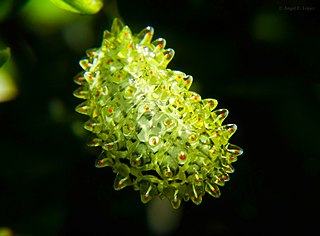
The Dalceridae are a small family of zygaenoid moths with some 80 known species encompassing about one dozen genera mostly found in the Neotropical region with a few reaching the far south of the Nearctic region.

Acraga is a genus of moths of the family Dalceridae. The genus has neotropical distribution.
Acraga luteola is a moth of the family Dalceridae. It is found in northern Brazil. The habitat probably consists of tropical moist forests.
Acraga infusa, the yellow furry-legs, is a moth of the family Dalceridae. It is found in Guatemala, Belize, Costa Rica, Panama, Colombia, Venezuela, Trinidad, Guyana, Suriname, French Guiana, Ecuador, Brazil, Peru, Bolivia and Paraguay.
Acraga serrata is a moth of the family Dalceridae. It is found in the Amazon Basin in Brazil and Peru. The habitat consists of tropical moist forests.

Acraga moorei, the tangerine furry-legs, is a moth of the family Dalceridae. It is found in Venezuela, Colombia, Brazil, Ecuador, Peru, Bolivia, Paraguay and northern Argentina.

Acraga coa is a moth of the family Dalceridae. It is found in southern Mexico, Belize, Honduras, Guatemala, El Salvador, Costa Rica and Panama. The habitat consists of tropical wet, tropical moist, tropical premontane wet, tropical premontane rain, tropical lower montane moist, subtropical wet, subtropical moist, subtropical dry and warm temperate wet forests.
Acraga meridensis is a moth of the family Dalceridae. It is found in the Andes Mountains of Venezuela and Colombia. The habitat probably consists of tropical premontane and lower montane moist or wet forests.
Acraga mariala is a moth of the family Dalceridae. It is found in Colombia. The habitat consists of tropical lower montane or premontane wet and tropical lower montane moist forests.
Acraga hoppiana is a moth of the family Dalceridae. It is found in Colombia and Ecuador. The habitat consists of tropical wet, Tropical lower montane dry and possibly in tropical premontane rain forests.
Acraga puno is a moth in the family Dalceridae. It was described by S.E. Miller in 1994. It is found in southern Peru. The habitat consists of tropical moist and tropical premontane wet forests.
Acraga boliviana is a moth in the family Dalceridae. It was described by Walter Hopp in 1921. It is found in Bolivia and western Brazil. The habitat consists of subtropical moist forests.
Acraga angulifera is a moth in the family Dalceridae. It was described by William Schaus in 1905. It is found in Trinidad, Venezuela, Suriname and French Guiana. The habitat consists of tropical moist forests.
Acraga isothea is a moth in the family Dalceridae. It was described by Paul Dognin in 1914. It is found in Costa Rica and Panama. The habitat consists of tropical premontane wet and rain forests.
Acraga leberna is a moth in the family Dalceridae. It was described by Herbert Druce in 1890. It is found in Panama and in northern half of South America.
Acraga umbrifera is a moth in the family Dalceridae. It was described by William Schaus in 1905. It is found in French Guiana. The habitat consists of tropical moist forests.
Acraga sexquicentenaria is a moth in the family Dalceridae. It was described by Ricardo Orfila in 1961. It is found in southern Brazil, northern Uruguay, and northern Argentina.
Acraga parana is a moth in the family Dalceridae. It was described by S.E. Miller in 1994. It is found in southern Brazil and Paraguay. The habitat consists of subtropical wet, subtropical moist and warm temperate moist forests.
Acraga conda is a moth in the family Dalceridae. It was described by Harrison Gray Dyar Jr. in 1911. It is found in the Guianas.
Acraga philetera is a moth in the family Dalceridae. It was described by William Schaus in 1910. It is found in Costa Rica.

